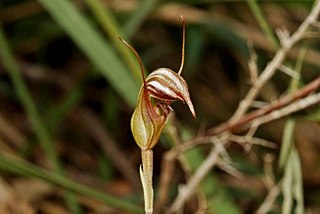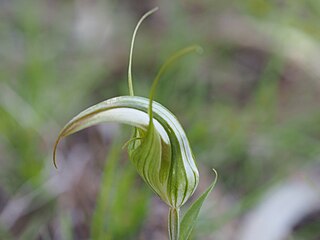
Pterostylis coccina, commonly known as the scarlet greenhood, is a species of orchid endemic to eastern Australia. As with similar greenhoods, the flowering plants differ from those which are not flowering. The non-flowering plants have a rosette of leaves flat on the ground but the flowering plants have a single flower with leaves on the flowering spike. In this species, the rosette leaves are relatively large and dark green, and the flowers are white, and bluish-green or red. It grows in New South Wales and north-eastern Victoria.

Pterostylis baptistii, commonly known as the king greenhood, is a species of orchid endemic to eastern Australia. Flowering plants have a rosette of stalked, dark green leaves and a single white flower with green and brown markings, and a wide gap between the petals and lateral sepals. It occurs mostly in New South Wales but is also found in coastal Queensland and north-eastern Victoria.

Pterostylis acuminata, commonly known as the sharp greenhood or pointed greenhood is a species of orchid endemic to eastern Australia. It has a rosette of leaves and a single green and white flower, leaning forward with a brown point on the end of the labellum.

Pterostylis atrans, commonly known as the dark-tip greenhood or blunt-tongue greenhood, is a species of orchid endemic to south-eastern Australia. As with similar greenhoods, plants in flower differ from those that are not flowering. The non-flowering plants have a rosette of leaves flat on the ground, but the plants in flower have a single flower with leaves on the flowering spike. In this species, the flower is green and reddish brown with a protruding sinus and small club-like tips on the ends of the lateral sepals.

Pterostylis concinna, commonly known as the trim greenhood, is a species of orchid endemic to south-eastern Australia and which usually grows in colonies. It has a rosette of leaves at the base and a single dark green, white and orange-red flower.

Pterostylis dolichochila, commonly known as the long-tongued shell orchid, is a species of orchid endemic to southern Australia. As with similar orchids, the flowering plants differ from those which are not flowering. The non-flowering plants have a rosette of leaves but the flowering plants have a single flower with leaves on the flowering spike. This greenhood has a green and white flower with reddish-brown stripes and a sharply pointed dorsal sepal.

Pterostylis longipetala, commonly known as the curved greenhood, is a species of orchid endemic to eastern Australia. As with similar greenhoods, the flowering plants differ from those which are not flowering. The non-flowering plants have a rosette of leaves flat on the ground but the flowering plants have a single flower with leaves on the flowering spike. This greenhood has dark green, brown and white flowers which lean slightly forwards and have sharply-pointed petals and a long, curved labellum.
Pterostylis allantoidea, commonly known as the shy greenhood is a species of orchid which is endemic to the south-west of Western Australia. It has a large rosette of leaves at the base of a flowering spike and a single white flower with green or reddish-brown stripes.
Pterostylis anatona, commonly known as the Eungella greenhood, is a species of orchid endemic to Queensland. It has a rosette of wrinkled leaves at the base of the plant and a single light green and white flower, reddish towards its tip. It grows in higher areas between Eungella and the Blackdown Tableland National Park.

Pterostylis sp. aff. alata is a species of orchid endemic to New South Wales but which has not yet been formally described. Non-flowering plants have a rosette of leaves but the flowering plants have a single flower with leaves on the flowering spike. This greenhood has a white flower with green markings and a brown-tipped dorsal sepal. It is only known from areas near Armidale where it grows near south-facing escarpments.

Pterostylis collina, commonly known as the shiny bull orchid, is a species of orchid endemic to New South Wales. It has a rosette of leaves and when flowering, a single reddish-brown, green and white flower with a curved top.
Pterostylis crassichila, commonly known as the plump northern greenhood, is a species of orchid endemic to Queensland. It has a rosette of leaves at the base of the plant and a single white flower with green lines, reddish towards its tip. It grows in higher areas of north Queensland.
Pterostylis erythroconcha, commonly known as the red shell orchid, is a species of orchid endemic to South Australia. As with similar orchids, the flowering plants differ from those which are not flowering. The non-flowering plants have a rosette of leaves but the flowering plants have a single flower with leaves on the flowering spike. This greenhood has a white and green flower with reddish brown markings and a long, fleshy, curved labellum.
Pterostylis humilis is a species of orchid endemic to New Zealand. It has a rosette of leaves at the base of the plant and when flowering stem, leaves which usually obscure the dark green and white flower.
Pterostylis irwinii is a species of greenhood orchid endemic to New Zealand. Flowering plants have erect, linear leaves on the flowering stem while non-flowering plants have a rosette of egg-shaped leaves. There is a single green flower with translucent white stripes and reddish-brown tips.

Pterostylis longicurva, commonly known as the long-tongued greenhood, is a species of orchid endemic to eastern Australia. As with similar greenhoods, plants in flower differ from those that are not. Those not in flower have a rosette of leaves lying flat on the ground, but plants in flower have a single flower with leaves on the flowering stem. This species has a white and green flower with brown markings and a long, curved, brown labellum.
Pterostylis procera, commonly known as the short-lipped greenhood, is a species of orchid endemic to Queensland. It has a rosette of leaves and when flowering a single translucent white flower with green and reddish markings and a labellum which does not protrude through the lateral sepals.

Pterostylis reflexa, commonly known as the dainty greenhood, is a species of orchid endemic to New South Wales. As with similar greenhoods, the flowering plants differ from those which are not flowering. The non-flowering plants have a rosette of leaves flat on the ground but the flowering plants have a single flower with leaves on the flowering stem. This greenhood has a relatively large white, green and light brown flower with a long, curved dorsal sepal and a protruding labellum.
Pterostylis riparia, commonly known as the streamside greenhood, is a plant in the orchid family Orchidaceae and is endemic to New South Wales. Both flowering and non-flowering plants have a rosette of dark green, fleshy leaves. Flowering plants have a single relatively large green, white and reddish-brown flower with a deeply notched sinus between hairy lateral sepals.
Pterostylis stricta, commonly known as the northern greenhood, is a species of orchid endemic to Queensland. It has a rosette of leaves and when flowering a single translucent white flower with green lines, a reddish-brown tip and a curved, protruding labellum.

















